Skip to comments.
The FReeper Foxhole Remembers the 110th Infantry at the Bulge (12/16-19/1944) - Dec 16th, 2003
www.historynet.com ^
| Gary Schreckengost
Posted on 12/16/2003 12:04:21 AM PST by SAMWolf
click here to read article
Navigation: use the links below to view more comments.
first previous 1-20, 21-40, 41-60, 61-80 ... 161-178 next last
To: Valin
1770 Ludwig van Beethoven Bonn Germany, composer (Ode to Joy)

 <===Mash This
<===Mash This
41
posted on
12/16/2003 9:21:40 AM PST
by
SAMWolf
(Capital Punishment means never having to say "you again?")
To: Darksheare
During the initial stages of the Battle most of the front had freezing rain, fog, cold and mud. The heavy snow and real cold came during the later stages of the battle.
42
posted on
12/16/2003 9:23:50 AM PST
by
SAMWolf
(Capital Punishment means never having to say "you again?")
To: Colonel_Flagg
Tasting it here too, but only got about 1-2" overnight, but the winds are the same, blowing it all over the place.
43
posted on
12/16/2003 9:24:31 AM PST
by
Johnny Gage
(God Bless President Bush, God Bless our Troops, and GOD BLESS AMERICA!)
To: snippy_about_it
LOL! I kept telling you it wasn't cold. ;-)
44
posted on
12/16/2003 9:24:44 AM PST
by
SAMWolf
(Capital Punishment means never having to say "you again?")
To: snippy_about_it; SAMWolf
Does fear and the fight to survive keep one warm? Or after a time do you just learn to live with the misery? I guess if you are cold and getting shot at, it could take your mind off the cold. Getting shot at might make you forget your misery.
A friend I used to work with said his Dad, lost two toes, during the Battle of the Bulge, from going to sleep with his feet in water at the bottom of his foxhole. I remember him saying his Dad didn't know his feet were frozen, till he tried to walk.
45
posted on
12/16/2003 9:26:13 AM PST
by
SCDogPapa
(In Dixie Land I'll take my stand to live and die in Dixie)
To: SAMWolf
LOL! I kept telling you it wasn't cold. ;-)And I'm kicking myself now. LOL. I swear on my way up the street, walking against the bitter wind I was saying, no snippy, THIS is cold!!!! Geez, what a rude awakening.
46
posted on
12/16/2003 9:26:58 AM PST
by
snippy_about_it
(Fall in --> The FReeper Foxhole. America's History. America's Soul.)
To: SCDogPapa
Morning SCDogPapa.
The Bulge like Gettysburg is one of the most written about and analyzed battles in America's History. I know I've always been fascinated by it since Grammar School, I have more books about the Bulge than any other battle in my Library.
47
posted on
12/16/2003 9:27:09 AM PST
by
SAMWolf
(Capital Punishment means never having to say "you again?")
To: Valin
Yeah I notice he doen't get a lot of snow and cold at his house. You might be on to something.
48
posted on
12/16/2003 9:36:16 AM PST
by
SAMWolf
(Capital Punishment means never having to say "you again?")
To: snippy_about_it
Is that the "flammable" nail polish? ROTFL!!!
49
posted on
12/16/2003 9:37:11 AM PST
by
SAMWolf
(Capital Punishment means never having to say "you again?")
To: bentfeather
I'll keep trying to find feathers for ya. :-)
50
posted on
12/16/2003 9:38:00 AM PST
by
SAMWolf
(Capital Punishment means never having to say "you again?")
To: SAMWolf
Is that the "flammable" nail polish? ROTFL!!!OMG, I had forgotten about that. ROTFLOL. Yep, that would be it.
51
posted on
12/16/2003 9:42:55 AM PST
by
snippy_about_it
(Fall in --> The FReeper Foxhole. America's History. America's Soul.)
To: SCDogPapa
During the winter of 1944-45, more than 500,000 troops were deployed in the Ardennes. An astonishing number -- 76,000 -- would be wounded or killed. The troops were young men -- some of them barely out of high school.
Freezing cold, frostbite, death -- these were everyday facts for the soldiers at the Bulge. This gallery of photos from the Battle of the Bulge shows some of what it was like.






52
posted on
12/16/2003 9:45:23 AM PST
by
SAMWolf
(Capital Punishment means never having to say "you again?")
To: snippy_about_it
Platoon Sergeant Lou Novotny
It was around December 28, 1944, in the vicinity of the town of Humain, Belgium. The morning was bitterly cold and foggy and the snow was about two feet deep with the fir trees covered with snow.
Our platoon was the point as we reconnoitered through the dense forest towards our objective, the high ground overlooking a snow and fog covered valley. The enemy lines being about 400 yards to our front.
We dug our fox holes securing our position until the orders came to attack the enemy.
The fog was heavy, visibility was only about 20 yards. Darkness began to set when the platoon leader met me. He was about to place concertina barbed wire in front of our defense positions.
The platoon leader was to make contact with the platoon on our left flank. I was to contact the platoon on the right flank.
We separated, with the fog getting dense and darkness falling rapidly. I thought I had walked more than far enough to contact the platoon on the right flank, so we could start setting up the barbed wire in front of our defensive position.
Getting near, I started to walk more slowly. I did not want to startle anyone as I came upon them out of the fog, thinking I was the enemy and be shot at.
Wondering when I would make contact, I slowed down considerably, walking in the wrong direction. Approaching enemy lines, I heard German voices. Visibility in the thick fog was about six feet. From the sounds I heard, I calculated that I was twenty yards from an enemy machine gun position.
If I had made a sharp step or sound, I would have been riddled with German gun fire.
Not knowing exactly where the enemy was, I listened again for their voices. When I heard the Germans speaking again, I slowly and quietly turned around and walked back safely to my platoon's position.
It seemed like ages before I made it back.
53
posted on
12/16/2003 9:46:58 AM PST
by
SAMWolf
(Capital Punishment means never having to say "you again?")
To: snippy_about_it; All
Was in this battle from the begining, but luck ran out on Jan 17, 1945, it was cold, lots of snow and then "BOOM," both legs below knee were gone. Now 85 yrs old and doing well, but will never forget that winter.
Frank Mazzarisi
St Petersburg, FL
Our Infantry training regiment at Camp Robinson, Arkansas, was about halfway through its 17-week training cycle in late December, 1944, when we fell out for roll call one morning and half the men weren't there. We found out later that members of Companies A and B had been shipped to what became known as the Battle of the Bulge (presumably during the night). I was in D Company and we and C Company remained. We finished training and, because the European war was winding down by then, we all were sent to the Pacific theater, where I stayed for another 18 months, but fortunately missed combat.
M.H.
Highland Park, IL
My father was captured in the Bulge Dec, 16. 1944 -- the same day I was born. He was missing in action for about two years.
When he finally was freed by an invasion of the camp, he was less than 100 lbs. We had his funeral Dec. 21, 2002 with full honors. 21 guns, his flag and all. I never talked with him about the details of his bad times, but one was he and another GI would go out at night and steal pototoes and heat them on the stove so they would not starve -- which they nerarly did. He did not live a normal life and spent time in Augusta Ga., Charleston. S.C., and Columbia, S.C. VA Hospitals. But I would not have wanted a better dad than mine! I want to do more reseach on his life in the Army. I miss him.
Walter B. Weatherly. jr
Greenville, SC
My grandfather fought in the bulge. I was very young when he died, about 7. I am not sure what the actual name of the division is -- there is a lion on the patch. Maybe the 127th? I never had any idea until recently in my life, as to what my grandfather did while he was over there. I myself was stationed in western Germany as a tanker while serving. My grandfather was a P.O.W. in Stalag Luft IV B. The memory of my grandfather is very dear to me. Any men out there that can add to my knowledge about my grandfather would be forever appreciated in this endeavor.
Jeremy Charles Richardson
Houston, TX
My grandfather, who is still alive and kicking today, was in the 17th airborne at the Battle of the Bulge. For many years he would not talk about what he had seen there. I know he must have seen much death because he still, to this day, has war souvenirs that he removed from dead Nazi soldiers. Some of the few things he has told me corresponded very closely to some of the interviews that were conducted on your program "Battle of the Bulge" -- such as taking friendly artillery fire. He also had to do many other desperate things to survive the war, like removing and wearing special winter clothing off of dead Nazi soldiers. He also mentioned the fact that he was unhappy with his originally issued rifle (I think was a M1 Carbine), and through the attrition of dead American soldiers he eventually wound up with a Thompson .45-caliber automatic machine gun and a Browning 12-gauge shot gun. I think my grandfather was suffering, in silence, for many years the shock and amazement of surviving the Battle of the Bulge.
C.B.
Las Vegas, NV
My father's older brother John "Jack" Robinson was involved in the first four days of the Battle of the Bulge. Jack Robinson was a sniper in the 422 Brigade of the 106th Fighting Lions Division. His unit was under an extremely heavy artillery assault at 5:30 am December 16, 1944. His brigade was the 422nd which was located between the 14th Calvary to the north and the 423rd Brigade located to the south. The Germans exploited the region occupied by the 14th Calvary which was the Loesmann Gap. The net effect of the German pincer moves isolated the 422nd and 423rd Brigades on the mountain called Ein Schieffel or Snow Mountain. His brigade attempted to counter-attack and escape the encircling move, but were not properly equipped and ran out of ammunition -- in particular, bazooka ammo. They had several skirmishes with the Germans but were forced to surrender about 4:30 pm December 19, 1944 when all ammunition was gone. (15,000 to 20,000) men of the 422nd were taken prisoner and began a long, twelve-day walk to German prisoner camps. John Robinson died of starvation and exposure on March 15, 1945. Based on those who survived the death prisons the survivors reported the prisoners got about 300 calories of bread per day. This German stavation diet was the demise of my father's brother. Please realize the Battle of the Bulge continued until these prisoners were liberated in May of 1945. My uncle's body did not return to the United States until August of 1950 due to Stalinist blackmail tactics.
Stephen D. Robinson (Would have been a nephew of John "Jack" Robinson)
Largo, FL
My dad, who passed away in 1990, was with the 28th Infantry. He fired one of those cannon-like guns. Dad spoke little of his time there (Dec.1944 through the duration). He really never cared to get the 3 Bronze Stars which I found out he was awarded. He told me enough to know that he had faced some very hard times in war, and I was always proud of him. I am 50 now. I have his uniform. I miss my dad now, and your show brings him close to mind. God Bless the people who were all around him there and when he came home. God Bless America. I feel very fortunate to live in this country where I have been surrounded by many unsung heros.
Vernon Swygert
Stockbridge, GA
Infantryman survivor. 84th Inf. Div. 333 rd. Company I (mine clearing) with the Division since La. training -- thru to the Elbe. In tears -- from the film this evening -- things I forgot and now reminded. Even my children never knew -- I could not tell.
Irwin L. Firschein
On Dec. 19th,1944 I was a Hitler Youth member. My mother & I had travelled a few weeks earlier to her hometown of Wiltz in northern Luxembourg.We got caught in the Battle of the Bulge while we where there.We were staying with a friend in town during that time. On Dec 19th, my schoolfriend Felix and I watched a column of German tanks descending into town from the Erpeldange Road, attempting to cross the Wiltz River Bridge. The bridge was defended by a platoon of GIs with 2 machine guns & a mortar. During the fight, 2 GIs were wounded & one was killed. One of the wounded was named Odis White as he was quartered in our friend's house. Before the Germans occupied the town, Pvt. White was brought into the house for treatment and then taken to Bastogne on a halftrack. The rest of the GIs left town shortly afterwards. By some strange co-incidence, last year 2001, on the computer, I met Pvt. White's son who lives in Texas. His father had died 2 years previously and had never told him how he was wounded. Well, I told him the whole story and the newspaper confirmed this. To tell it all, would take too many pages but, what a strange world? Now if you ask, yes, I was born in Germany and came to the US in 1995.
Wilhelm Gehlen
Johnson City, TN
54
posted on
12/16/2003 9:49:30 AM PST
by
SAMWolf
(Capital Punishment means never having to say "you again?")
To: *all
|
Air Power
Focke-Wolfe Ta-152
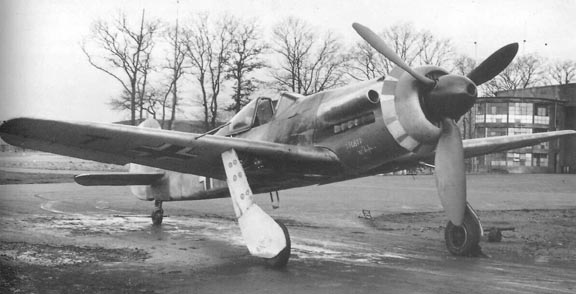 |
Before the end of 1940, the Focke-Wulf design bureau headed by Dipl.-Ing. Kurt Tank had initiated work on variants of the Fw 190 intended to improve its high-altitude performance. Three alternative proposals were considered, designated Fw 190B, C, and D. The Fw 190B was basically similar to the Fw 190A, but was to be powered by a BMW 801 radial boosted by nitrous-oxide (GM 1) injection pending the availability of an exhaust-driven turbosupercharger. A pressure cabin was to be fitted, and the wing area was to be increased. The Fw 190C was basically similar to the B but was to be powered by the Daimler Benz DB 603 liquid-cooled engine using either a mechanically-driven supercharger operating in conjunction with nitrous oxide injection or a turbosupercharger. The Fw 190D was powered by the Jumo 213. The Fw 190B and C both ran into an extensive series of teething problems, and, in the event, never entered production. Priority was therefore given to the Fw 190D even though Tank felt that that the DB 603 was a better high-altitude engine than the Jumo 213 and had greater development potential. The result was the superb "Dora" version of the Fw 190, which was described in a previous post.
When Germany declared war on the USA, the Luftwaffe had initially assumed that the Americans would give the war in the Pacific their first priority, and had not worried too much about high-altitude bombing raids from B-17 bombers. However, by the autumn of 1942, it became readily apparent that the USAAF was planning a full-scale massive bombing campaign against Germany from its bases in the UK, and that the Luftwaffe would soon require fighters with better high-altitude performances to face the threat from American bombers. By that time, the Luftwaffe was also aware of the existence of the B-29, and they were also aware that the existing Fw 190 would be incapable of effectively intercepting this American bomber at the altitudes at which it was supposedly capable of operating. Consequently, Dipl.-Ing Kurt Tank undertook the development of of a Hochleistungsjäger, or High-performance Fighter, offering a much improved combat ceiling.
The Luftwaffe envisaged a two-phase program for the production of its new high-altitude fighter. The first phase would produce an aircraft based to the extent possible on an existing production airframe. The second phase would design a fighter from the ground up specifically for the high-altitude role.
To meet the requirements of the first phase, Focke-Wulf proposed the Fw 190 Ra-2 and Ra-3 designs, both based on the Fw 190D. These two proposals were basically similar, differing from each other principally in wing span and armament, the Ra-2 having a standard Fw 190D wing and the Ra-3 having extended wing outer panels giving a wing with a rather high aspect ratio. The engine was to be a Jumo 213E with a a three-speed two-stage supercharger and induction cooler which offered superior high-altitude performance over the Jumo 213A. Both designs had a pressure cabin and provision for both nitrous oxide (GM 1) and methanol-water (MW50) injection. The fuselage was common to both models, and was lengthened to provide increased internal capacity. The cockpit was moved sixteen inches further aft in relation to the wing attachment points in order to balance the center of gravity. Vertical tail surfaces were enlarged, and both aircraft had a 30-mm engine-mounted cannon and a pair of 20-mm MG 151 cannon in the wing roots, however the Ra-2 was to have an additional pair of MG 151s in the upper deck of the forward fuselage.
The requirements of the second phase were to be met by the Fw 190 Ra-4D. Although it was based broadly on the Fw 190, the Ra-4D embodied a complete structural redesign and numerous aerodynamic refinements. It was from the start to use a turbosupercharged Daimler-Benz DB 603 engine, the engine which Kurt Tank had preferred all along.
Dipl.-Ing Kurt Tank had by this time obtained almost legendary status as a result of his successful aircraft designs, and the RLM decided to honor him by using the prefix "Ta" instead of "Fw" for aircraft coming out of his design bureau. Since the Ra-2 and Ra-3 were considered sufficiently different from their predecessors to deserve a new designation, they were the first to receive the new "Ta" prefix. They were both redesignated Ta 152 by the end of 1942. Logic would seem to dictate that the Ra-2 and Ra-3 be designated Ta 152H and K, since they followed on directly from the Fw 190F and G (I and J were not used as suffixes). However, Tank had a different idea. He proposed that the short-span Ra-2 be designated Ta 152B, where the B stood for Begeleitjäger or Escort Fighter, and the long-span Ra-3 be designated Ta 152H, where the H stood for Hohenjäger or High-Altitude Fighter. Such was the prestige of Kurt Tank that he immediately got his way. The Ra-4D was assigned the designation Ta 153.
Although Tank was pressing the Luftwaffe to allocate production priority to the Ta 152, the authorities were reluctant to disrupt existing assembly lines for the introduction of a new type. Consequently, the work on the Ta 152 proceeded only very slowly, and it was not until the spring of 1944 that serious preparations for production were begun. By that time, the USAAF bomber offensive was in full gear, and the Luftwaffe was in dire straits. The Luftwaffe desperately needed a counter to the P-51 Mustang which was cutting German fighters to pieces.
The wing of the proposed Ra-4D/Ta 153 had a slightly greater span and area than that of the Fw 190D. This wing was seen to have certain advantages over the wing originally envisaged for the Ta 152. In addition to having better aerodynamic characteristics, the Ta 153 wing was deemed easier to manufacture and was capable of carrying more fuel. The Luftwaffe consequently proposed that that the new wing be adopted for the Ta 152B, with the outboard panels and flaps being extended for the long-span Ta 152H.
Kurt Tank was still pressing for permission to use the DB 603 engine in the Ta 152, owing to its superiority over the Jumo 213E at high altitudes. Although the Luftwaffe still insisted that the Jumo 213E remain the primary Ta 152 powerplant, it permitted Tank to begin work on a DB 603-powered version under the designation Ta 152C. There was no designation conflict with the Fw 190C, since all work on that version had been abandoned by this time owing to chronic turbosupercharger problems.
The first Ta 152H prototypes were completed in the summer of 1944.
Several Fw 190C airframes were used in the project. The first Ta 152H-0 service test aircraft rolled off the assembly lines in October-November 1944. The Ta 152H-0s had no fuel tanks in their wings. They were joined a month later by the first production Ta 152H-1 aircraft, which had fuel tanks in the wings. The Ta 152H-1 was armed with one engine-mounted 30-mm MK 108 cannon with 90 rounds and two 20-mm MG 151 cannon in the wings with 175 rpg. 330 pounds of armor were carried for the protection of the engine and the pilot. Most production machines were delivered to Ta 152H-1/R11 bad-weather fighter standards. A MW 50 boost tank was fitted in the inboard port wing tank for use in enhancing low-altitude performance, with the GM 1 high-altitude boost tank aft of the cockpit being standard.
Approximately 150 Ta 1252H-1 fighters were manufactured between January 1, 1945 and the final abandoning of production with the arrival of Soviet forces at the Cottbus assembly plant. No Jagdgruppen ever completely converted to the type, but several Jagdstaffeln operated the Ta 152H alongside the Fw 190D and other types. Most of the Ta 152s operated in the close-support role. Others flew "top-cover" for bases from which Messerschmitt Me 262 jet fighters operated, trying to protect the jets from being "bounced" by Allied fighters during takeoff or landing. It was said that no British or American fighters risked attacking an Me 262 during landing while Ta 152s were known to be circling the airfield. The large wing area of the Ta 152 made it quite easy to fly. Most of the Ta 152Hs, however, were destroyed on the ground by Allied air attacks while awaiting delivery. A few Ta 152Hs were allocated to the Mistel program.
Near the end of 1944, Kurt Tank himself had a narrow escape while flying one of his Ta 152Hs. He was flying from Langenhagen near Hannover to attend a meeting at the Focke-Wulf plant in Cottbus. His plane carried armament, but no ammunition. Shortly after takeoff, he was jumped by four Mustangs. Tank pressed the button which activated his MW 50 boost, opened the throttle wide, and quickly left the Mustangs far behind in a cloud of blue smoke.
Engine: Junkers Jumo 213E-1 twelve-cylinder liquid-cooled engine rated at 1750 hp for takeoff (2050 hp with MW 50 boost) and 1320 hp at 32,800 feet (1740 feet with GM 1 boost). Maximum speed: 332 mph at sea level (350 mph with MW 50 boost), 465 mph at 29,530 feet with MW 50 boost, 472 mph at 41,010 feet with GM 1 boost. Service ceiling was 48,550 feet with GM 1 boost. Initial climb rate was 3445 feet/minute with MW 50 boost. Weights were 8642 pounds empty, 10,472 pounds normal loaded, 11,502 pounds maximum. Wingspan 47 feet 41/2 inches, length 35 feet 1 2/3 inches, height 11 feet 0 1/4 inches, wing area 250.8 square feet.
The Ta 152B has originally been envisaged as having interchangeable Jumo 213 or DB 603 "power eggs", but with the acceptance of the Ta 152C the Jumo 213 was standardized. The original plan to install cabin pressurization was abandoned. However, it was decided to give higher priority to the Ta 152C, and only three prototypes of the Ta 152B-series were completed before the war came to an end.
Series production orders for the Ta 152C had been placed in October 1944, the delays being a result of the Luftwaffe still continuing to support the Jumo 213 over the DB 603 for the Ta 152 as late as the autumn of 1944. The Ta 152C with the lighter DB 603 engine was otherwise identical to the Ta 152B. It was considered primarily as a Zerstorer. The MW 50 boost installation for the enhancement of low-altitude performance was standard. An Fw 190D prototype had been rebuilt and flown with a DB 603 engine in support of the Ta 152C program, and this plane took to the air for the first time in October 1944. During December 1944 and January 1945, the first Ta 152C-O service test aircraft joined the test program. The definitive production version was to be the Ta 152C-1, and it was hoped that the first examples could be rolling off the production lines in April of 1945. However, series production of the Ta 152C was only just beginning when Allied forces overran the assembly plants, so this fighter never entered service with the Luftwaffe.
The Ta 152C-1 was powered by a Daimler-Benz DB 603LA twelve-cylinder liquid cooled engine rated at 2100 hp (2300 hp with MW 50) for takeoff and 1750 hp at 29,530 feet (1900 hp at 27,560 feet with MW 50). Armed with one engine-mounted 30-mm MK 108 cannon with 90 rounds, two fuselage-mounted 20-mm MG 151 cannon with 250 rpg, and two wing-mounted 20-mm MG252 cannon with 175 rpg. Maximum speed was 227 mph at sea level (356 mph with MW 50), 436 mph at 37,730 feet (460 mph at 32,810 feet with MW 50). Initial climb rate was 3050 feet per minute and service ceiling was 40,350 feet. Weights were 8849 lbs empty, 10,658 lbs normal loaded, and 11,733 pounds maximum. Wingspan was 36 feet 1 inch, length was 35 feet 6 1/2 inches, height was 11 feet 1 inch, and wing area was 290.89 square feet.
There is a long and complex list of experimental subtypes (both actual and proposed) of the Ta 152B, C, and H, much too long to list here. See one of the references listed below if you are really interested.
Some Ta 152s are known to have been captured and returned to the USA for study. I wonder if any of them still exist? Perhaps a Ta 152 is squirreled away in a dark corner in one of the hangars of the Garber facility at Suitland, Maryland. Anyone know?
Specifications:
Origin: Focke-Wulf Flugzeugbau GmbH
Type: Single-seat high altitude fighter
Crew: One
Powerplant: One Junkers Jumo 213E-1 12-cylinder inverted Vee,liquid cooled with MW-50 injection and GM-1 boosting (1,740 hp)
Dimensions:
Wing Span: 14.5m (47 ft. 6¾ in.)
Length: 10.8m (35ft 5¼ in.)
Height: 4m (13 ft. 1.5 in.)
Wheel Track: 3.95m (12 ft. 11 in.)
Weights: Empty: 3,600kg (7,940 lbs.) / Loaded: 5,500kg (12,125 lbs.)
Performance :
Maximum speed: 431mph at 34,451 ft. - 466mph at 29,529 ft. with MW-50 - 472mph at 41,012 ft. with MW-50 and GM-1
Climb rate: 1000m/minute
Ceiling: 48,560 ft.
Range (Internal fuel): 1200km (745 Miles)
Armaments:
One 30mm MK 108 mounted between the cylinder heads, firing through the propeller hub - Ammunition: 90 Rounds
Two inboard wing mounted 20mm MG151/20 - Ammunition: 175 Rounds Each
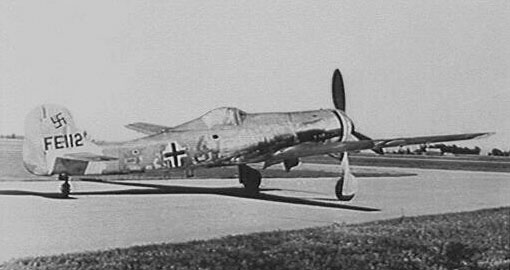


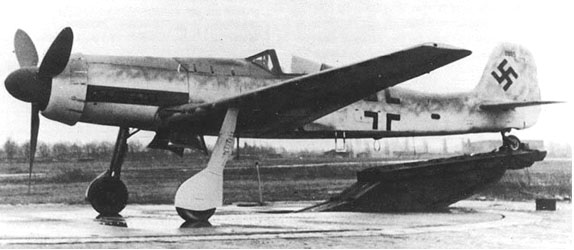
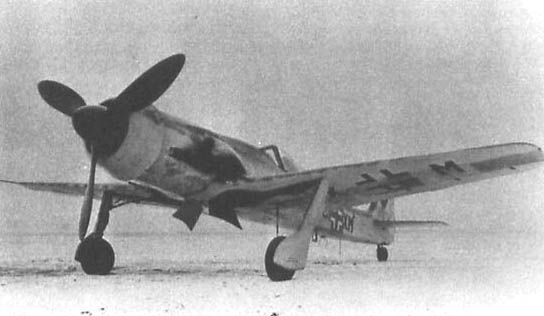
All information and photos Copyright of
Warbird Resource Group
55
posted on
12/16/2003 10:00:20 AM PST
by
Johnny Gage
(God Bless President Bush, God Bless our Troops, and GOD BLESS AMERICA!)
To: Johnny Gage
Great vintage iron. Thanks
To: Johnny Gage
Thanks for profiling the "Long Nose". I still like the original FW-190, it just looked meaner.

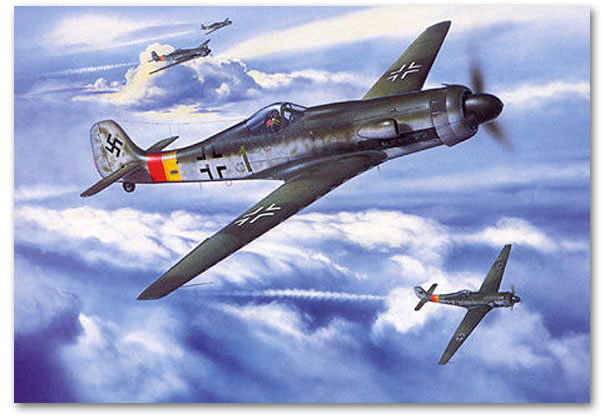
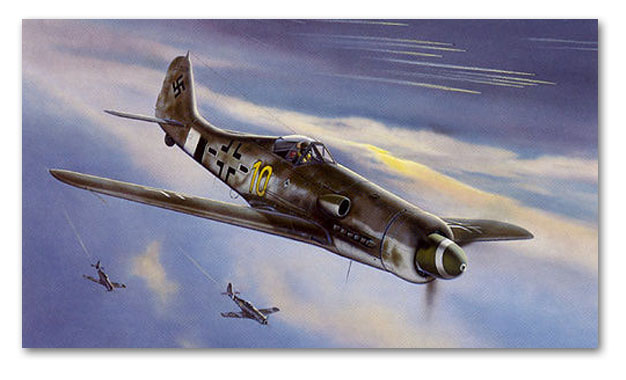
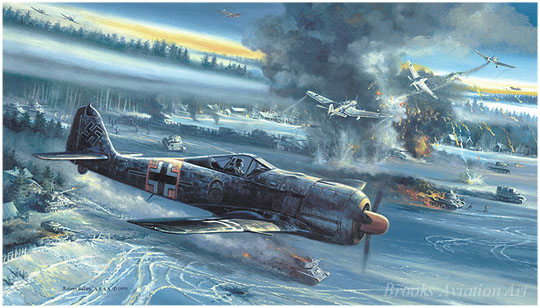
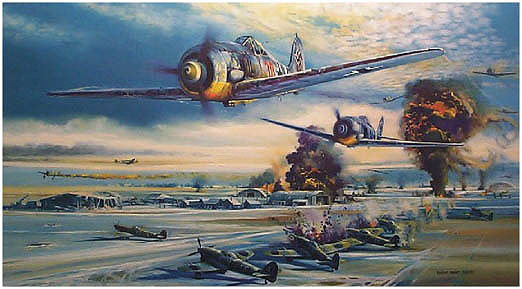
57
posted on
12/16/2003 10:29:32 AM PST
by
SAMWolf
(Capital Punishment means never having to say "you again?")
To: Johnny Gage
I've never seen a Ta-152 at any of the Aircraft Museums I've visited. I guess only the Smithsonian has one for sure.
The National Air and Space Museum's Ta 152 is the only extant example of this fighter in the world today. NASM is also the only museum in the world that has preserved examples of the three major Fw 190 variants: the Fw 190F-8, the Fw 190D-9, and the Ta 152H-0. Each aircraft was built by the same manufacturer, but at different stages of the war and for different missions. Together, the trio offers a unique insight into German fighter development during World War II.
58
posted on
12/16/2003 10:33:50 AM PST
by
SAMWolf
(Capital Punishment means never having to say "you again?")
To: SAMWolf
Freezing cold, frostbite, death -- these were everyday facts for the soldiers at the Bulge. What a miserable place to be.
Thanks for the pictures Sam.
59
posted on
12/16/2003 10:34:45 AM PST
by
SCDogPapa
(In Dixie Land I'll take my stand to live and die in Dixie)
To: SCDogPapa; snippy_about_it; All
You're welcome SCDogPapa.
Bob Conroy: The Sound of Bullets
We went through Belgium. Other than the fellow that lost the battle to the tank, the unit stayed pretty well together psychologically. We finished there and went into another battle. It was a three-day battle. Non-stop. Limited food. A fantastic battle. It was in the woods in defensive indian style. We were right behind a small hill. You could hear it going on. You could hear the German machine guns. They had a "bbrrppp" sound. And there were four of them right about 100 yards in front of us. And you could hear ours. We had some lights in-action and we had some heavies in-action in the woods. And the heavies go "bum, bum, bum, bum, bum, bum, bum, bum" and you have two pairs of them. And they have a rhythm to them, sort of like a symphony. And as we were listening we could hear one of the guns get knocked out. You hear the one on the right just took up a double beat until the replacement crew could come in and pick it up again. The bullets are whizzing through the trees over your head and, in that particular situation, I was along side of the captain and he was begging to get into it. I didn't share his enthusiasm, but we went on through that battle. Lasted three days. We didn't have much anything in the way of food and we didn't have anything in the way of sleep.
Ed Stewart: Artillery Fire
It has a screaming sound sometimes, of course, the mortar is dangerous because it has no sound it just drops. Because it's a high angle, it comes on down, because sometimes you hear a pop if it's not too far off. But it's the screaming sound of 288s, which was a major artillery on the part of the Germans, and at first it's absolutely frightening, it's a nightmare. It puts you into another nightmarish existence. I eventually get accustomed to it and begin to make judgements about it. Is it coming in close? Is it going to go far or what? And you begin to be able to estimate pretty much where it's going to hit. And then you're...the sound itself is replaced by the need to make a judgement about it. So it hit here, you know the pattern of the firing. It comes in threes. And then it's fifty yards out, it's twenty-five, well how about the third one? So then you become preoccupied with that. You almost begin to like the sound because this gives you some information of what you might do, or what's going to happen.
Ronald N. McArthur Wounded in Action
At the beginning of the Battle of the Bulge, our outfit was a good many miles southeast of the breakthrough point. I was the first gunner in our section of water-cooled 30 caliber machine guns. We were a Heavy Weapons Company of the 45th Division, part of General Patch's 7th Army. We were ordered out between Christmas and New Year's to help close the gap in the line. We traveled nearly a day and a night in a northwesterly direction to our assigned area. We were attached to a rifle company to replace their light 30 caliber machine guns that had been knocked out in the attack.
We set our guns up on the high ground on each side of a trail in the woods. There were several tanks with us in the attack. It was all quiet nearly all afternoon, only a few small arms fired at us during the day. Then, all of a sudden at about four o' clock, we were hit with a terrific artillery barrage. The shells were coming in hitting the trees and exploding. We were exposed to vicious tree burst shrapnel coming down on us.
After some time, I told my assistant gunner to man the gun as I was going out to cut some large branch logs that had been knocked down from the shelling. This was afternoon, January 11, 1945. The logs were to be placed over our foxhole to protect from further shell bursts. I left the gun and went about 100 yards toward the lead tank that had been knocked out during the battle. I got about four logs cut when WHAM, I was shot through the face by a German sniper. He had been left behind as we drove Germans off the hill. He was out in front of the knocked out tank.
I fell flat on my face in about 15" of snow. My only thought was, "When will he let me have it again?" The bullet must have been a soft-nosed one as X-rays later revealed that I had pieces of shrapnel in my cheek and the roof of my mouth. The bullet had gone through my left cheek just below the jaw bone and exited out my right cheek, taking nearly all of upper teeth and gums as well as most of the lowers. I remember feeling numbness in my mouth. I thought my tongue was gone. I put my hand in the opening and was relieved to find it intact. The opening of the right cheek was up to under my eye and back nearly to my right ear.
Our medic was nearby. He came and patched the wounds with sulphadiazine powder. In short order, our jeep was there (each section of machine guns had its own jeep). They took me and another GI out to be evacuated to an aid station and several hospitals on my way finally to England and later home, the good old USA.
60
posted on
12/16/2003 10:38:19 AM PST
by
SAMWolf
(Capital Punishment means never having to say "you again?")
Navigation: use the links below to view more comments.
first previous 1-20, 21-40, 41-60, 61-80 ... 161-178 next last
Disclaimer:
Opinions posted on Free Republic are those of the individual
posters and do not necessarily represent the opinion of Free Republic or its
management. All materials posted herein are protected by copyright law and the
exemption for fair use of copyrighted works.
FreeRepublic.com is powered by software copyright 2000-2008 John Robinson

 <===Mash This
<===Mash This














